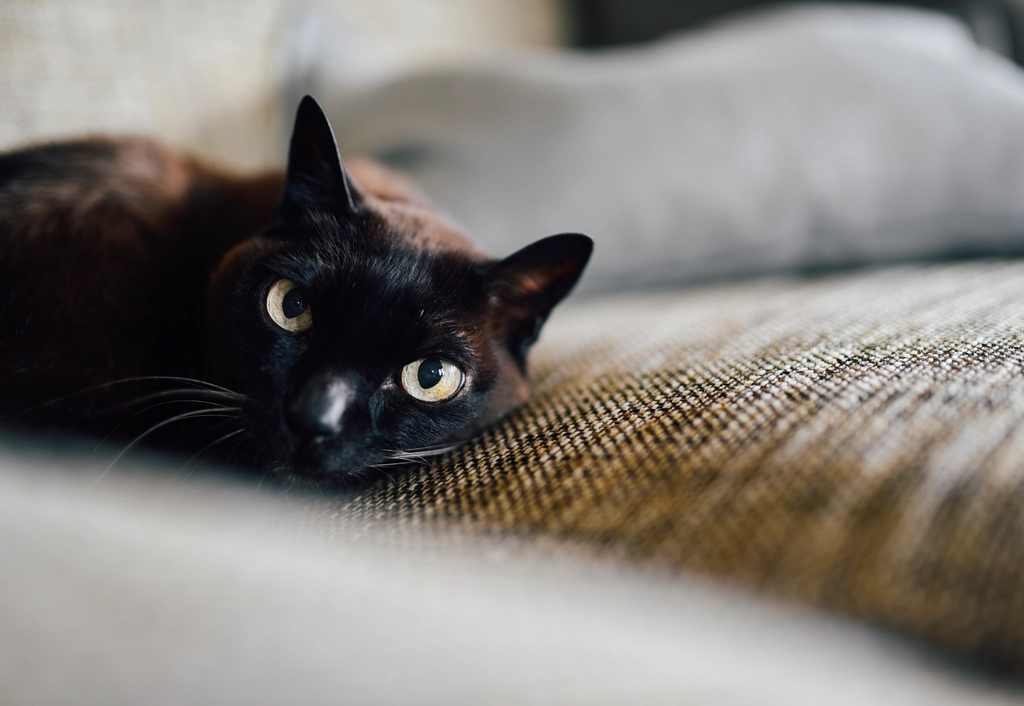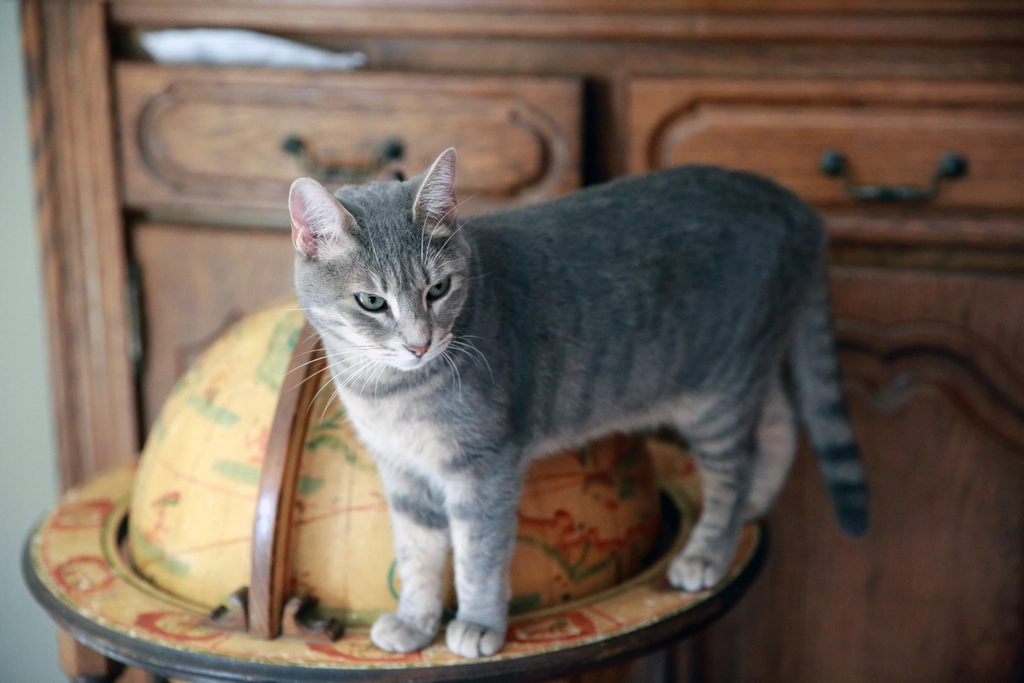Cats, with their enigmatic glances and graceful movements, have captivated humans for centuries. Understanding a cat’s personality can be an intriguing venture. After all, you get a glimpse into their world this way. Remember, the key to unraveling this mystery lies in observing their body language. Just like humans communicate with gestures and facial expressions, cats express their feelings and intentions through their bodies. This article will guide you through 12 different body language cues that will help you decode your feline friend’s personality.
The Tale Behind the Tail
A cat’s tail is a fascinating indicator of their mood and personality. A high, upright tail often signifies a happy and confident cat, while a puffed-up tail can be a sign of fear or aggression. If your cat’s tail is wagging slowly, it could mean they are focused or interested in something. Conversely, rapid tail flicking might indicate irritation. Observing these tail movements regularly will give you a better understanding of your cat’s emotional state. Just like a flag, a cat’s tail sends signals about their disposition, and learning to read these signals is key to understanding them.
Eye Contact and Blinks

The eyes are often considered windows to the soul, and in cats, they offer significant clues about their personality. Direct eye contact from a cat can be a sign of trust and affection. The slow blink, often referred to as a “kitty kiss,” is a gesture of love and relaxation. If your cat gives you a slow blink, try returning it to strengthen your bond. However, prolonged staring without blinking might indicate that your cat is feeling threatened or anxious. Understanding these subtle eye movements can greatly enhance your connection with your cat.
Ear Position and Movement
Cats use their ears not just for hearing but also for communication. Ears facing forward usually indicate that your cat is relaxed or curious about their surroundings. If the ears are sideways or backward, your cat might be feeling anxious or threatened. Rapid ear twitching can signify annoyance or overstimulation. By observing the position and movement of your cat’s ears, you can gain insight into their comfort level and emotional state. Think of a cat’s ears as little radar dishes, constantly scanning and interpreting their environment.
The Subtle Art of Whisker Communication
Whiskers are more than just adorable features on a cat’s face; they are powerful tools for communication. When a cat is curious or excited, their whiskers will be pushed forward. Conversely, whiskers pulled back against the face can indicate fear or aggression. Neutral whiskers suggest a relaxed state. These delicate sensory organs can provide you with clues about your cat’s mood and personality, allowing you to better respond to their needs. Whiskers, much like antennae, help cats navigate their world and communicate their feelings.
Pawing and Kneading

Pawing and kneading are behaviors that cats often exhibit when they’re feeling content or affectionate. These actions can be traced back to kittenhood, when kittens knead their mothers to stimulate milk flow. If your cat kneads on you, consider it a compliment; they see you as a source of comfort and security. However, excessive pawing or kneading might indicate anxiety or a need for attention. By observing these behaviors, you can gain insight into your cat’s emotional state and strengthen your bond with them.
Posture and Positioning
A cat’s posture can tell you a lot about how they’re feeling. A relaxed cat will often lie on their side or back, exposing their belly—a sign of trust. Hunched postures or crouching might indicate stress or discomfort. An arched back, with fur standing on end, is a classic sign of fear or aggression. Understanding these postures can help you assess your cat’s personality and emotional well-being. Like a living sculpture, a cat’s body tells a story, and learning to read that story is key to understanding them.
Vocalizations and Their Meanings
While body language is crucial, vocalizations also play an important role in a cat’s communication. Cats use a variety of sounds, from purring to hissing, to express their feelings. A soft purr usually indicates contentment, while a loud, persistent meow might mean they want attention or food. Growling or hissing are clear signs of distress or aggression. By paying attention to these vocal cues, you can better understand your cat’s personality and respond appropriately to their needs.
Grooming Habits and Social Interactions

Grooming is a significant aspect of a cat’s life, and their grooming habits can offer clues about their personality. Cats that groom themselves frequently are often confident and relaxed. If your cat grooms you, it’s a sign of affection and inclusion in their social circle. On the other hand, excessive grooming might indicate stress or a medical issue. Observing your cat’s grooming habits and social interactions can provide valuable insights into their personality and overall well-being.
The Language of Play
Play is a vital part of a cat’s life and a wonderful way to understand their personality. Cats that enjoy interactive play with toys or other animals are often social and energetic. Solitary play with inanimate objects can indicate an independent nature. The way a cat plays can also reveal their hunting instincts, as well as their preferences and dislikes. Engaging with your cat in play not only strengthens your bond but also provides you with a window into their unique personality.
Feeding Behavior and Preferences
A cat’s eating habits can be surprisingly telling about their personality. Some cats prefer to eat alone, indicating a more solitary nature, while others enjoy mealtime companionship. Observing your cat’s food preferences and feeding behavior can provide insights into their health and personality. Changes in eating habits might signal stress or a medical issue. By understanding and respecting your cat’s feeding preferences, you can better cater to their needs and foster a more harmonious relationship.
Response to New Environments
Cats are creatures of habit, and their response to new environments can reveal a lot about their personality. Some cats are adventurous and curious, quickly exploring new spaces, while others may be more cautious and take time to adjust. Observing how your cat reacts to changes in their environment can help you understand their temperament and adaptability. Whether they’re explorers or homebodies, understanding your cat’s response to new environments is essential for providing them with a comfortable and happy life.
Understanding Personal Space

Cats are known for their independent nature, and respecting their personal space is crucial. Some cats enjoy close contact and cuddling, while others prefer to keep their distance. Understanding your cat’s boundaries and respecting their need for personal space can enhance your relationship with them. By observing how your cat interacts with you and their environment, you can gain valuable insights into their personality and preferences. Like any relationship, mutual respect and understanding are key to a harmonious coexistence.
Understanding your cat’s personality through their body language is a rewarding journey that strengthens the bond between you and your feline friend. By paying attention to these subtle cues, you can better meet their needs and provide a loving, supportive environment. Each cat is unique, and learning to interpret their body language opens the door to a deeper, more meaningful connection.
Jen is a passionate nature lover and ocean conservationist. She has dedicated her life to protecting the environment and preserving the beauty of the natural world. Growing up in a small coastal town, Jen sincerely appreciated the ocean and its inhabitants. She has spent countless hours exploring the shoreline, learning about the creatures that inhabit the waters, and advocating for their protection. Jen is an active member of ocean conservation organizations, and she is committed to educating the public about the importance of conserving wildlife and the natural environment.





